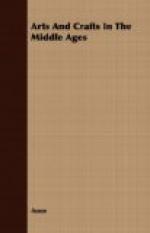One of the richest suits of armour in the world is to be seen at Windsor; it is of Italian workmanship, and is made of steel, blued and gilded, with wonderfully minute decorations of damascene and applique work. This most ornate armour was made chiefly for show, and not for the field: for knights to appear in their official capacity, and for jousting at tournaments, which were practically social events. In the days of Henry VIII. a chronicler tells of a jouster who “tourneyed in harneyse all of gilt from the head piece to the sabattons.” Many had “tassels of fine gold” on their suits.
Italian weapons called “lasquenets” were very deadly. In a letter from Albrecht Duerer to Pirckheimer, he alludes to them, as having “roncions with two hundred and eighteen points: and if they pink a man with any of these, the man is dead, as they are all poisoned.”
Bronze is composed of copper with an alloy of about eight or ten per cent. of tin. The fusing of these two metals produces the brown glossy substance called bronze, which is so different from either of them. The art of the bronze caster is a very old and interesting one. The method of proceeding has varied very little with the centuries. A statue to be cast either in silver or bronze would be treated in the following manner.
A general semblance of the finished work was first set up in clay; then over this a layer of wax was laid, as thick as the final bronze was intended to be. The wax was then worked with tools and by hand until it took on the exact form designed for the finished product. Then a crust of clay was laid over the wax; on this were added other coatings of clay, until quite a thick shell of clay surrounded the wax. The whole was then subjected to fervent heat, and the wax all melted out, leaving a space between the core and the outer shell. Into this space the liquid bronze was poured, and after it had cooled and hardened the outer shell was broken off, leaving the statue in bronze exactly as the wax had been.
Cellini relates an experience in Paris, with an old man eighty years of age, one of the most famous bronze casters whom he had engaged to assist him in his work for Francis I. Something went wrong with the furnace, and the poor old man was so upset and “got into such a stew” that he fell upon the floor, and Benvenuto picked him up fancying him to be dead: “Howbeit,” explains Cellini, “I had a great beaker of the choicest wine brought him,... I mixed a large bumper of wine for the old man, who was groaning away like anything, and I bade him most winning-wise to drink, and said: ’Drink, my father, for in yonder furnace has entered in a devil, who is making all this mischief, and, look you, we’ll just let him bide there a couple of days, till he gets jolly well bored, and then will you and I together in the space of three hours firing, make this metal run, like so much batter, and without any exertion at all.’ The old fellow drank and then I




